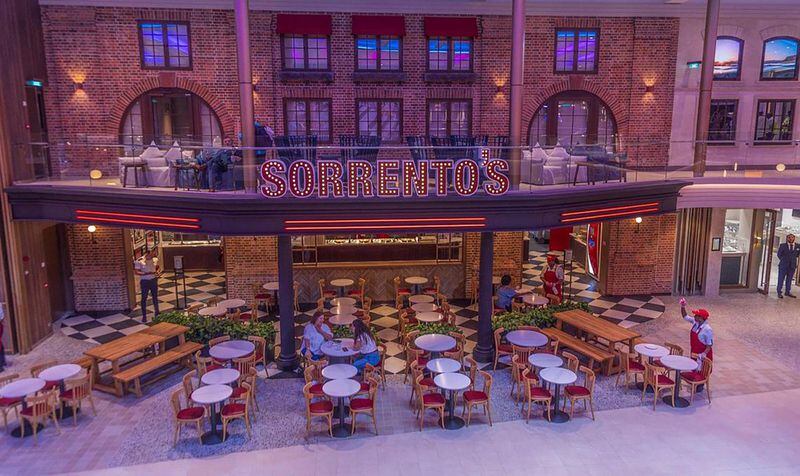MIAMI — The first thing passengers entering the Icon of the Seas and its central walkway notice is a gigantic orb structure. Called the Pearl, it is a five-deck-tall glass surface supported by steel and lined on the inside with more than 3,000 tiles.
Right under it is a majestic staircase, one reminiscent of an Italian palace, that takes guests up to the Pearl Café on one side and a Latin nightclub on the other. Tall windows abound.
The Pearl structure allows the ship to have a much more open design and layout, which results in far greater natural light and exposure to the sea when compared to other vessels owned by Royal Caribbean International.
“One reason the Pearl exists is to get ocean views at the heart of the ship,” Jay Schneider, chief product innovation officer for Royal Caribbean, said in an interview with the Miami Herald. “It feeds the energy of the royal promenade.”
After much anticipation and hype, the 1,198-foot-long vessel with a capacity of 5,610 guests reached PortMiami on Jan. 10. It will be based here year round focused on weeklong or shorter trips to the Caribbean. Royal Caribbean International’s headquarters are also here.
It has more than 40 restaurants and drinking establishments, including two dueling piano bars, three-story townhouses for large families, and more than 33,000 plants in what it dubs Central Park, one of its neighborhoods.
About 1,000 people visited the Icon and its 19 decks Jan. 11. They were largely media and employees with Royal Caribbean.
Employees then began a two-night demo cruise to the Bahamas. Royal Caribbean will have a few more short trips for them, their families, and then travel agents and VIPs. That all comes ahead of its first cruise for the public, scheduled for Jan. 27.
Inside the world’s biggest cruise ship
The Icon of the Seas is the first new class of ships from Royal Caribbean in nearly a decade. With 2,850 staterooms; 18 guest decks; seven pools, each with two lifeguards; and 2,350 crew, it is considered by cruise industry experts the largest cruise ship in the world at the moment.
Schneider, Royal Caribbean’s chief product innovation officer, told the Herald there were multiple goals in creating this new class of ship. One was making it easier to get around.
“We’ve heard over the years challenges guests have had with movement around the ship,” he said. “Our focus has been to dramatically improve that.”
The Pearl is one of their solutions. The open structure permits passengers to go from Deck 2 to Deck 8 without having to go out of the way to find an elevator.
The company also sought to open up its venues. For example, it has the Latin nightclub on its other ships but with a closed facade. On the Icon, they removed the facade.
Another main objective with the Icon is to provide what the Royal Caribbean executive called “unrivaled water experiences,” or to surround passengers by water or the ocean as much as possible. That means pools facing the sea — one is at one edge of the ship — and even beds that can be adjusted to ensure they face the ocean.
“You are going to have this whole sense that you are part of this ship but also part of the sea,” said John Lovell, president of Travel Leaders Group.
On Deck 16′s Chill Island is a swim-up full-service bar called Swim & Tonic. Guests can order and imbibe drinks while seated in chairs half-immersed in the pool or hot tub. And whichever option one chooses, there’s a great view of the sea.
Thrill Island, also on Deck 16 and one of eight neighborhoods, has six waterslides, a surfing area, a rock-climbing wall facing the ocean, and a mini-golf course. An adventure called Crown’s Edge allows thrill seekers to hang 154 feet above the ocean.
Royal Caribbean also wanted to up its game in catering to families and in providing food and entertainment, Schneider said.
At the highest end is the Empire Supper Club, which offers eight-course meals, including caviar and wagyu. Every dish there is paired with a drink.
Most eateries are casual, though, such as a family-style Italian restaurant and Pearl Café, which makes fresh sandwiches, ready-made salads and desserts. Izumu offers Japanese street food and Japanese taiyaki ice cream, and there are more Hibachi tables on the Icon.
Sorrento’s, a popular pizza slice place on Royal Caribbean’s Oasis class of ships, is redesigned with more counter space and with the goal of reducing lines and improving flow of guests, which was becoming a complaint.
“We wanted to get rid of the lines as much as possible,” Schneider said.
Pearl’s Café's importance stems from feedback the company got that passengers want more food they can take out or grab and go when in a rush, especially those with kids who are on the move.
Credit: TNS
Credit: TNS
The final details
Little about the Icon has been rushed. It’s been a long time in the making, going back to at least 2017.
The general plan for the ship and arrangement of decks were all locked in by 2018. The design of the interiors and the number of rooms were finalized by 2019. Construction broke ground with steel cutting in June 2021.
Still, in recent weeks and months, work has not stopped. After construction at the Meyer Turku shipyard in Turku, Finland, there were sea trials last June, October and November.
A Herald reporter visited Schneider at his office in Miami on Nov. 13, days after he returned from Finland and right after the final sea trial.
He said then they had a list of about three dozen requested changes to try to make.
In one case, his team noticed the planned lights on the counter of the lobby bar were much bigger than they seemed on paper, reducing guests’ access to the bartenders.
And so, those lights “are all getting removed,” Schneider said.
Meanwhile, the company decided it should up its game in mini-golf and make the course more tied to Thrill Island and thematic. So, in November, it added sunken boats and a fallen plane.
Thrill Island itself came together only in the past two years.
In 2021, the ship had four waterslides and one tower, and then six but still one tower. It also had a rock-climbing wall farther away. But that did not seem right, so they decided to bring them all closer together.
They also added a second tower. The goal is now that at full capacity, if every kid wants to go on a ride, wait times will be under 20 minutes, Schneider said.
Meanwhile, at the Pearl Café, as of November, it had a glass barrier between the coffee barista at one end and the customers. The original idea was the guest would order coffee and then receive it at the other end of the counter on the assumption he or she bought other items like sandwiches or pastries. And there would be one point of sale.
But on one of the many walk-throughs the company did, the food and beverage team objected to the glass barrier, thinking it impeded the flow of guests.
“It looked great designed this way but as we started to operationalize, the team said it’d be really helpful if we didn’t have the glass panel over there,” Schneider said.
On Jan. 11, there was no glass barrier.







